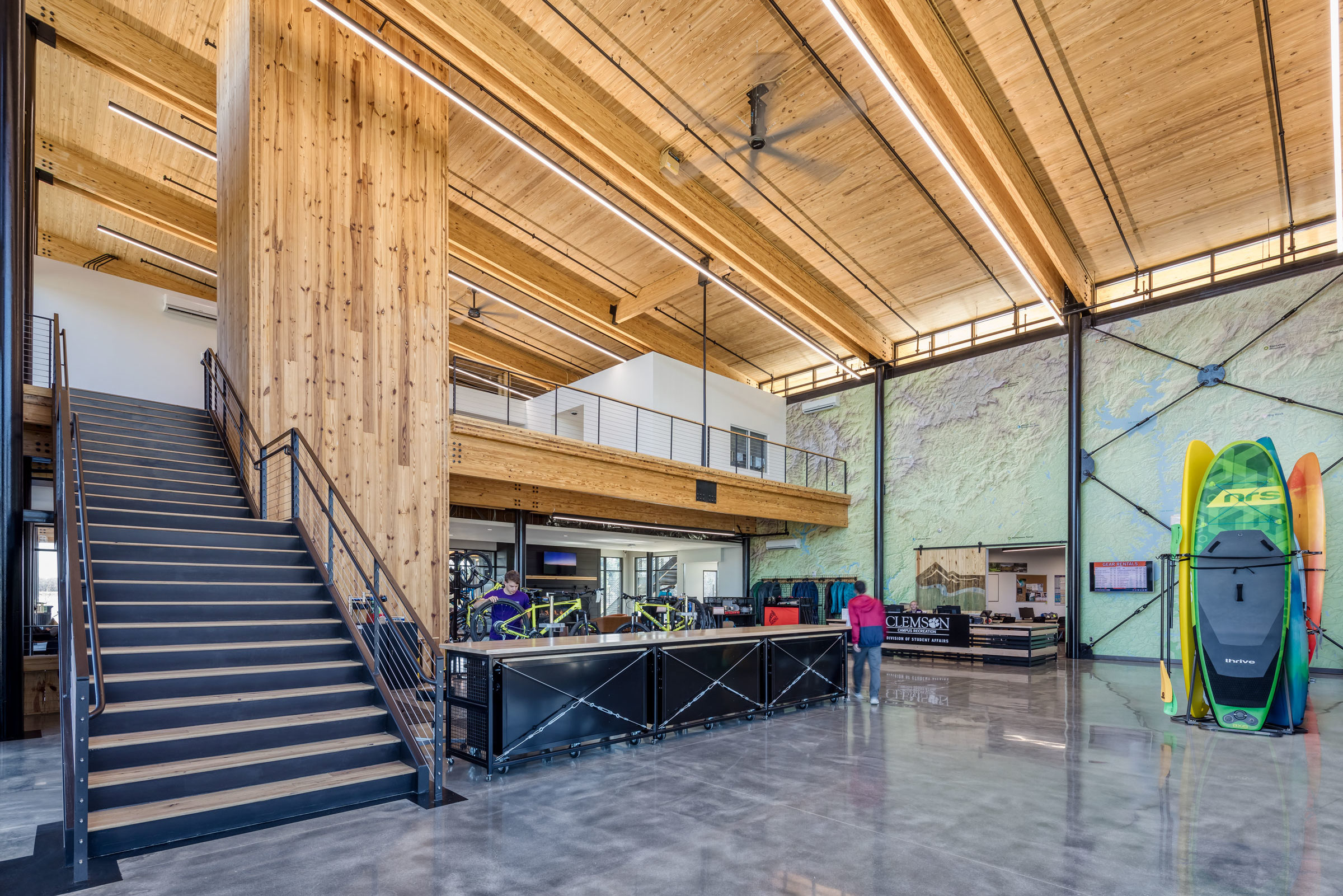Story at a glance:
- Daylighting, insulation, and acoustic design can improve health among occupants of a building.
- Both wall insulation and acoustic design can limit the harmful impacts of noise pollution.
- Antimicrobial materials like quartz, copper, and silver promote hygiene.
Our health is largely dependent on environmental factors like our access to quality water, air, and daylight. When we consider this, it’s easy to see how important it is for designers to ask, “How can architecture improve health?”
Various design elements—like choosing a nontoxic paint or increasing access to green spaces—can boost occupants’ wellness within the built environment. Many of these design elements reduce stress, germs, and noise within a space, allowing occupants to feel at ease.
Let’s explore 14 ways architecture and the built environment can positively affect occupant health.
14 Ways Architecture Can Improve Health
1. Choose Nontoxic Materials

The wood products and paint used throughout Urban Frontier House are all free of Red List ingredients. Photo by Clark Marten
While it’s common knowledge that materials like lead and asbestos are bad for our health, there are plenty of other building materials that contain toxic or otherwise harmful chemicals—like volatile organic compounds (VOCs)—that are known to pose a threat to human and ecosystem health. Long-term exposure to these toxins can lead to endocrine disruption, reproductive toxicity, chronic or acute organ toxicity, and even some cancers.
When choosing materials or products for a project, cross-reference their ingredients with the International Living Future Institute’s Red List—the industry’s most comprehensive guide to these “worst in class” chemicals and chemical compounds. Products that bear a Red List–free label fully disclose 100% of their ingredients at or above 100 ppm in the final product and do not contain any chemicals on the Red List.
2. Air-Sealing to Improve IAQ

Air sealing gaps and cracks in a building’s envelope can help prevent pollutants from entering unfiltered and reduces the likelihood of moisture buildup that could otherwise lead to mold and mildew growth. This ultimately makes for better indoor air quality and helps prevent the development of respiratory illnesses. Photo courtesy of Aeroseal
Leaks and gaps in a building’s envelope are a major source of energy waste but also allow moisture and unfiltered particles like dust and pollen to enter, adding to interior air pollution. Locating and sealing these areas of intrusion—such as around windows and doors, in attics and basements, around outlets and plumbing, et cetera—can significantly increase indoor air quality by reducing the risk of hidden mold growth while also reducing stress on existing ventilation systems.
Aeroseal is a leading provider of duct and air sealing technologies, offering a range of products designed to improve indoor air quality, elevate occupant health and comfort, and deliver premium energy savings.
3. Promote Healthy Eating With Rooftop Gardens

Casa Adelante’s seventh floor and rooftop area are dedicated to urban agriculture. Rooftop gardens like these help residents make healthier dietary choices, which in turn reduces the risk of heart disease, high blood pressure, and other chronic health conditions. Photo by Bruce Damonte
Although we don’t often think about how architecture influences our eating choices and habits, there’s a reason why green building rating systems like WELL have a “Nourishment” scoring category. Considering our society’s plethora of processed foods, many people fail to get their recommended daily serving of fruit and vegetables.
Incorporating edible food gardens into the design of buildings can help promote healthier eating habits and reconnect people with the earth. The LMSA-designed Casa Adelante affordable housing complex in San Francisco has dedicated its seventh story and roof space to urban agriculture and food production, enabling residents to cultivate herbs, fruits, and vegetables for their own consumption.
Providing opportunities to grow a portion of one’s own food also goes a long way in fighting food insecurity, reducing the risk of developing chronic health conditions like diabetes, heart disease, high blood pressure, and more. “Food insecurity is a very big and valid concern for the populations the building serves. This idea of combining food and housing security together helps with these huge housing issues that are present in San Francisco and elsewhere,” Ryan Jang, principal at LMSA, told gb&d.
Aside from improving physical health, there is a growing pool of scientific evidence that suggests gardening is beneficial to mental health as well, with studies showing a positive correlation between gardening and reduced stress, anger, fatigue, depression, and anxiety symptoms.
4. Provide Access to Green Spaces

Access to green spaces and views of vegetation are known to help improve mental health and can even facilitate quicker hospital recoveries. Khoo Teck Puat Hospital in Singapore leverages this to its full advantage. Photo courtesy of International Living Future Institute
Even if occupants aren’t directly getting their hands dirty gardening, studies show vegetation and green spaces in general have a positive impact on the human psyche, helping to reduce stress and increase productivity. This can be as simple as adding a few potted plants throughout a building or, for designers looking for something a bit more permanent, as complex as a living wall or green roof.
Green spaces like these invite visitors and staff to go outside, breathe fresh air, and interact with the natural world in a more intimate manner. Research shows access to these sorts of spaces—even if just a visual connection—can improve psychological health and reduce stress, which in turn can help hospital patients recover faster, improve employee productivity, and reduce depression rates in residential buildings.
At the Khoo Teck Puat Hospital in Singapore, plants and water features are built into the building to contribute to wellness. “With Khoo Teck Puat we see that biophilic design elements and attributes should not only be considered as part of the design process, but also as part of the healing process,” architect Stephen Kieran previously told gb&d.
5. Ergonomic Furniture & Flooring
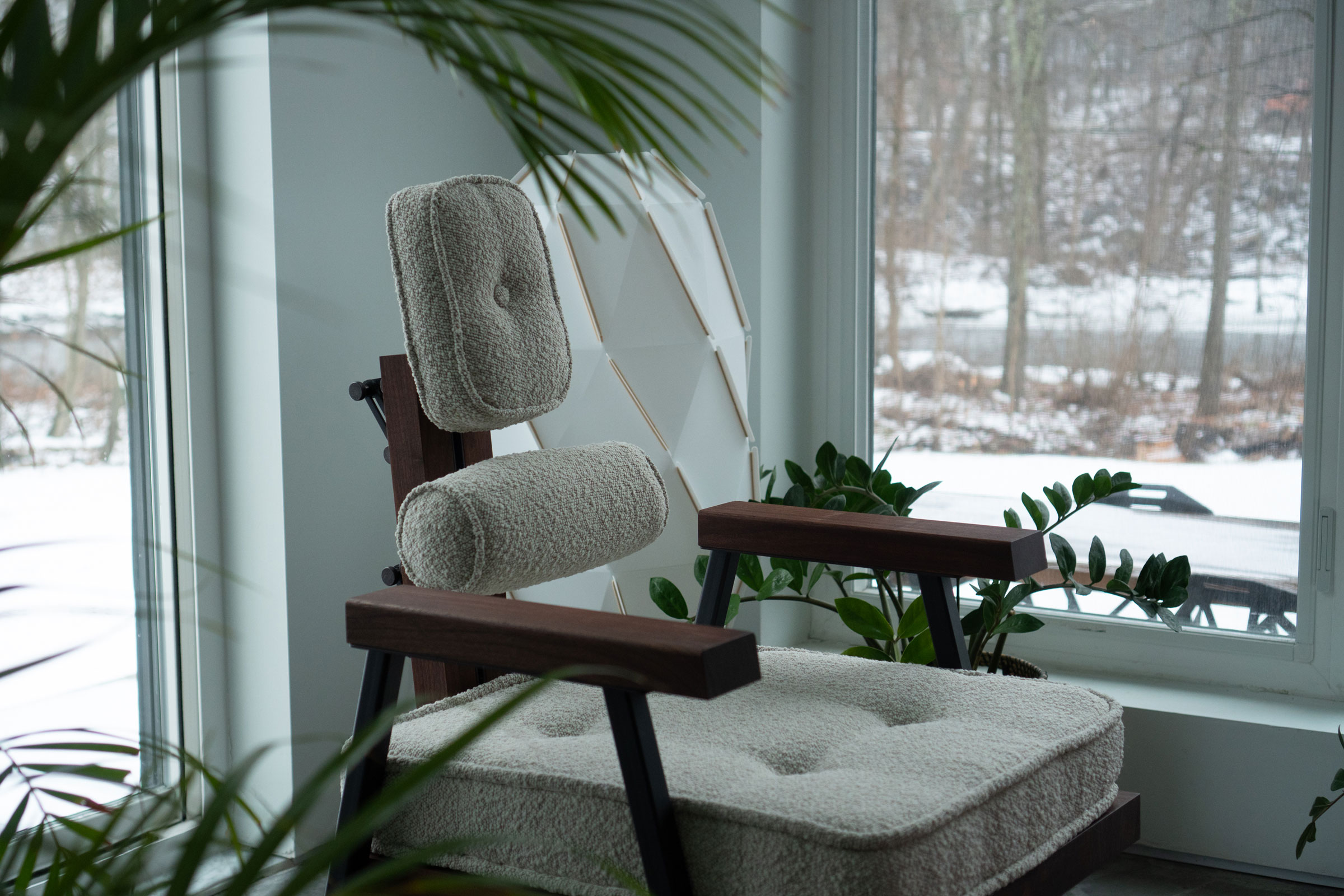
Head of Marble’s Ergonomic Chair is designed to chiropractic standards to facilitate perfect posture. Photo courtesy of Head of Marble
Another way buildings—specifically office buildings, schools, and medical facilities—can help improve health is by providing occupants and employees with more ergonomic furniture. This is particularly true of chairs and other seating options, especially in a day and age where more and more people are working on laptops and computers.
Leading eco-friendly furniture company Head of Marble offers a range of comfortable seating options, including the aptly named Ergonomic Chair. Fully adjustable and built to chiropractic standards, the Ergonomic Chair is designed to facilitate proper posture and perfect lumbar support, helping to prevent back, shoulder, and neck pain.
Aside from comfortable seating options, ergonomic furniture also includes things like footrests to help avoid joint pain, boost circulation, and improve posture; adjustable keyboard trays that allow for better positioning and wrist support, helping to reduce neck strain and reduce the risk of developing carpal tunnel syndrome; and combination sit/standing desks that give employees the opportunity to stretch their legs throughout the day.
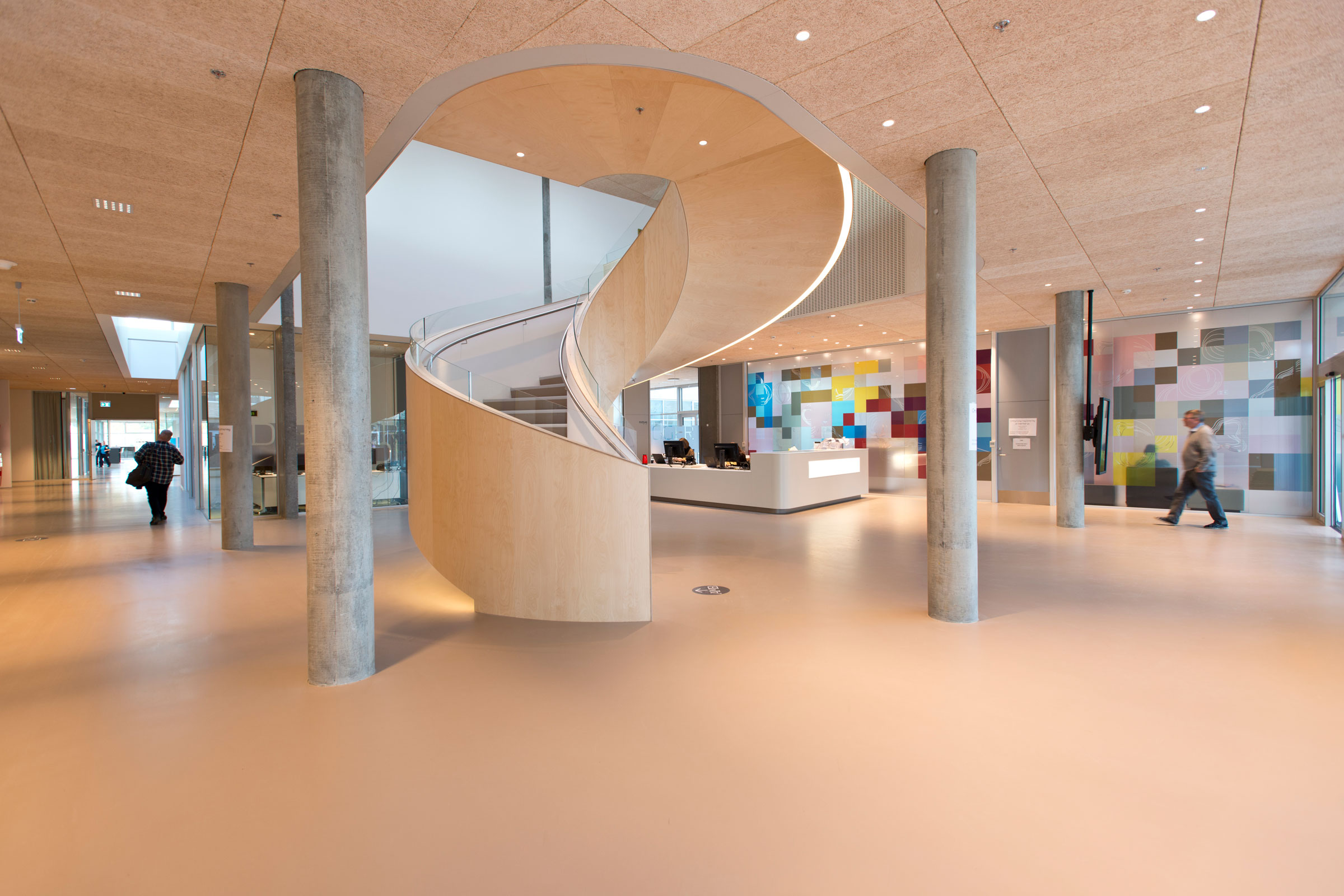
SofTop Comfort Systems combine versatile decor options with ergonomic comfort and noise reduction benefits that help meet the health and safety needs of institutional and commercial facilities. Photo courtesy of Sherwin-Williams
Flooring is another key area where ergonomics come into play. Standing or walking on hard, solid surfaces like concrete, hardwood flooring or tile for long periods of time can cause sore feet, knee pain, and backaches as they lack natural shock absorption qualities.
In areas that experience high foot traffic, experts recommend installing softer, springier flooring materials. This includes materials like rubber and elastomeric resins whose molecular structures afford them a natural cushioning ability that makes for more comfortable walking. Sherwin-Williams’ SofTop Comfort, for example, is a seamless fluid-applied elastomeric flooring that feels soft underfoot but still offers high durability and chemical resistance, making it an ideal choice for health care, education, hospitality, and other commercial and industrial settings.
6. Use Daylighting to Brighten a Space
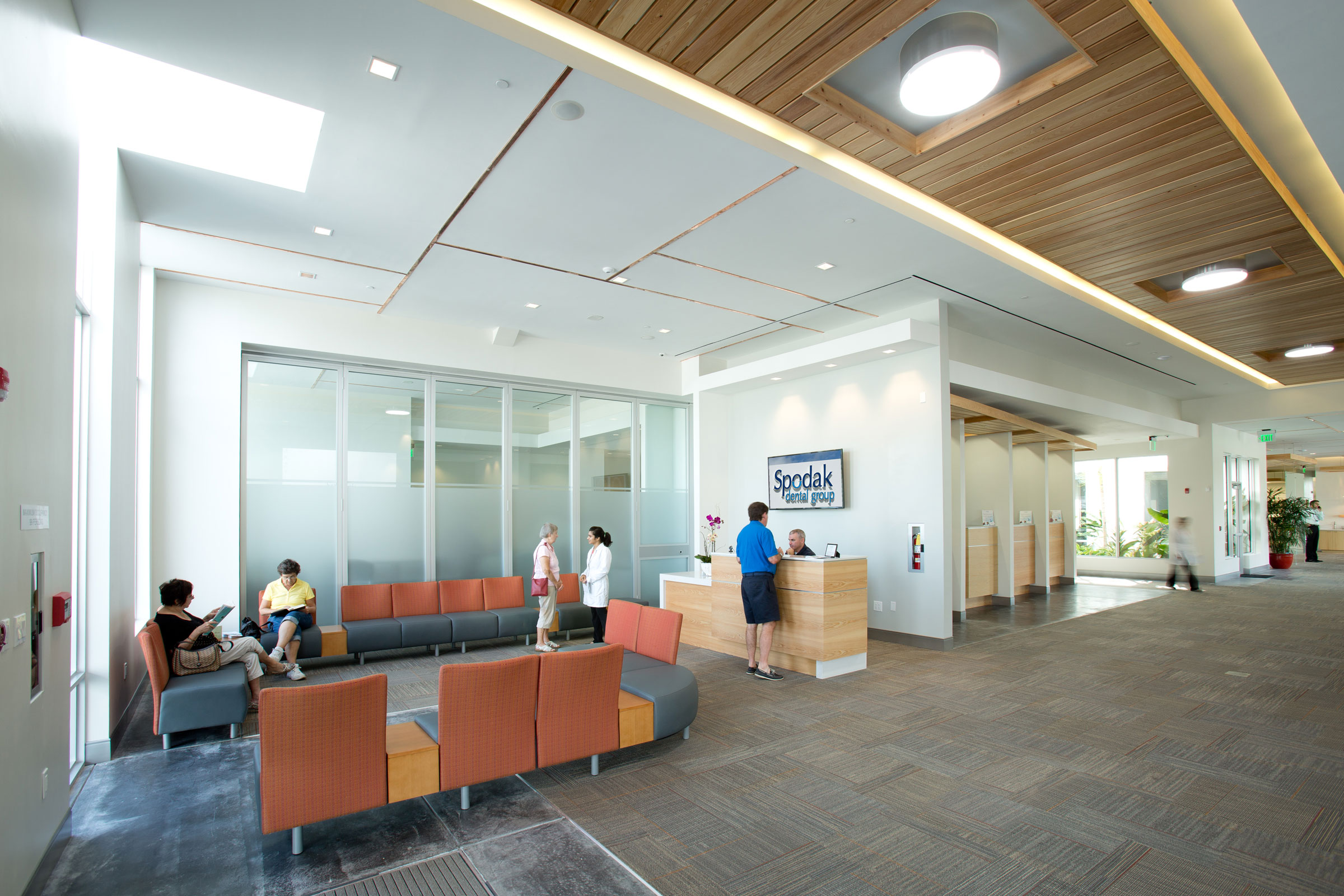
Tubular daylighting devices provide a bright, calm and friendly environment for patients entering any health care facility. Photo courtesy of Solatube International
Growing research tells us how important daylight is to maintaining wellness, in large part because of sunlight’s role in regulating the body’s circadian rhythm. “The human circadian rhythms are the body’s natural clock. When your brain detects daylight and the changing spectral content over the course of the day, it tells your body to wake you up, and when darkness hits, it triggers your body to fall asleep,” Neall Digert, vice president of innovation and market development at Kingspan Light + Air, previously wrote for gb&dPRO.
Most of us, however, spend a large portion of our days inside with little-to-no exposure to natural lighting for hours on end, resulting in feelings of premature tiredness and reduced productivity. Daylighting, or the practice of using windows, skylights, and other light-admitting features to illuminate a room, presents a solution to this problem, especially when implemented to scale throughout an entire building.
“By exposing your body to daylight throughout the day, your healthy human circadian rhythm will have a significant role in regulating your sleep-wake cycle and have a positive influence on your eating habits and digestion, body temperature, hormone release, and other important bodily functions,” Digert says.
The positive effect of natural sunlight is so strong that studies have shown patients who are treated in health care facilities with daylight are found to have less pain—therefore requiring less pain medication—and heal faster, subsequently having shorter hospital stays and overall lower medical costs. Scientists have also found that daylight even works as a disinfectant. UV light has been used as a disinfectant for decades, but a 2018 study demonstrated that rooms exposed to daylight also have fewer germs, a similar effect as UV light.
7. Opt for Continuous Superinsulation
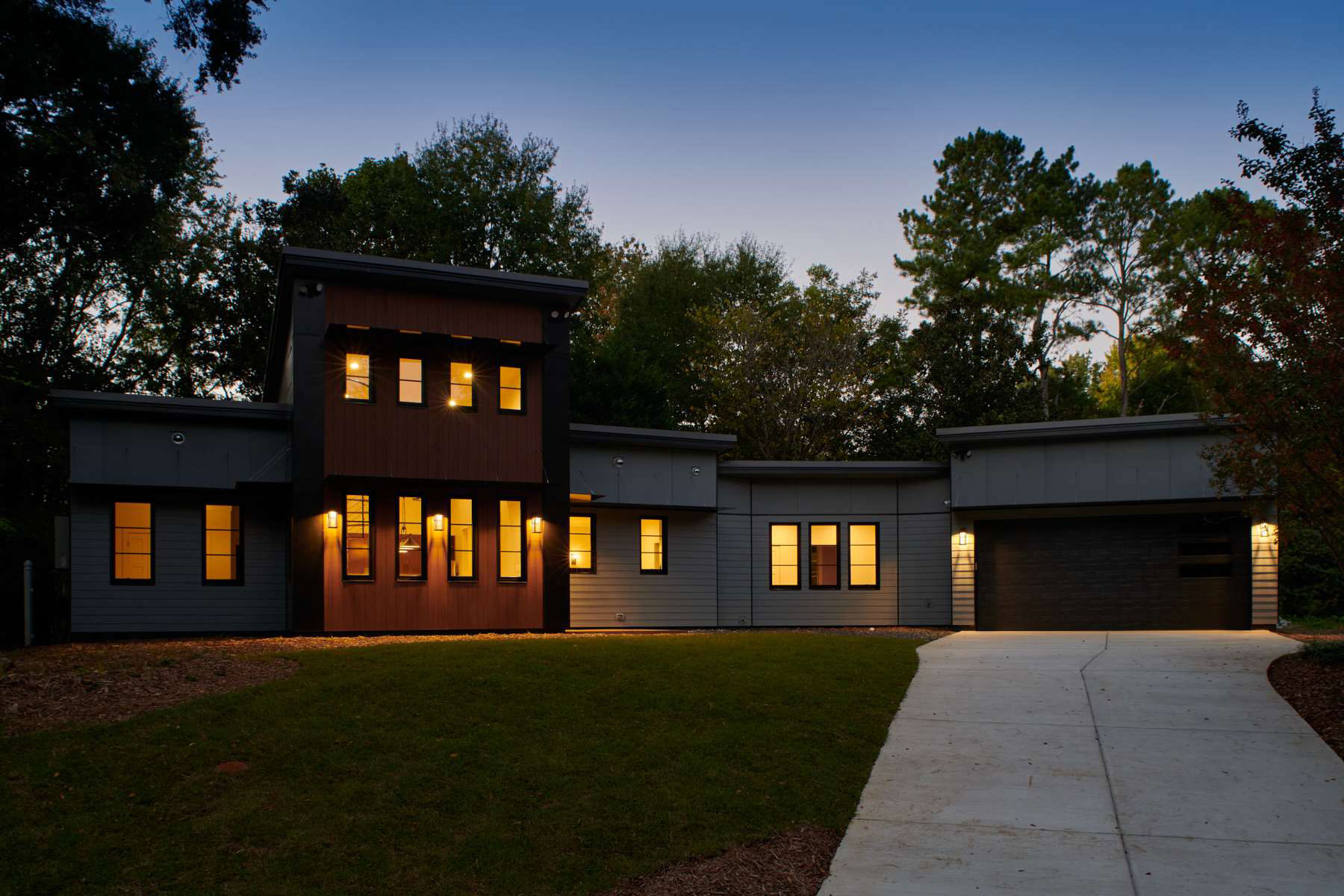
A contemporary three-bedroom house designed by LG Squared uses continuous stone wool insulation to keep the home a comfortable temperature while keeping energy demand low. Photo courtesy of LG Squared
While all buildings require some amount of insulation to meet code, the minimum insulation requirements set by many codebooks often leave something to be desired when it comes to maintaining a comfortable interior environment. Poor or insufficient insulation can lead to high energy bills and negatively impact health during both summer (heat-related illnesses) and winter (weakening of the immune system).
Continuous superinsulation can help prevent energy waste and avoid potential health issues. Continuous insulation helps reduce or eliminate thermal bridges, or those areas in which there is a direct connection between the interior and exterior through building components that possess a higher thermal conductivity than those materials surrounding them. Thermal bridges allow heat to enter or escape through a building’s envelope—contributing to energy waste—and can lead to unwanted condensation, moisture damage, and mold/mildew growth.
The term superinsulation, on the other hand, refers to any insulation with a very high R-value—typically R-40 for walls and R-60 for roofs—and is the gold standard when it comes to maintaining a high level of interior temperature control. Combined, continuous superinsulation helps to equalize a building’s temperature, meaning your body won’t need to adjust as you move from one room to the next, according to Jason Todd, director of market development and building science at Greenfiber.
8. Choose Nontoxic Paints & Finishes

Clare offers a variety of bright, low-VOC paint colors. Photo courtesy of Clare Paints
Paint colors can breathe life into interior spaces. But many paints also off-gas harmful toxins. Therefore it’s important to choose a nontoxic paint brand that is low in VOCs—the harmful carbon-containing chemicals that vaporize at room temperature and harm air quality. Over time these chemicals are released into the air through a process called off-gassing.
Nontoxic paint—labeled with Low VOC, VOC-Free, or No-VOC—can never be guaranteed to be 100% nontoxic. However, water-based paints are almost always going to be a safer option over oil-based paints with high VOCs.
Brands like Clare Paint come in a variety of bright colors that will liven up a space, and even offer delivery to your door.
9. Go Touchless to Limit the Spread of Germs
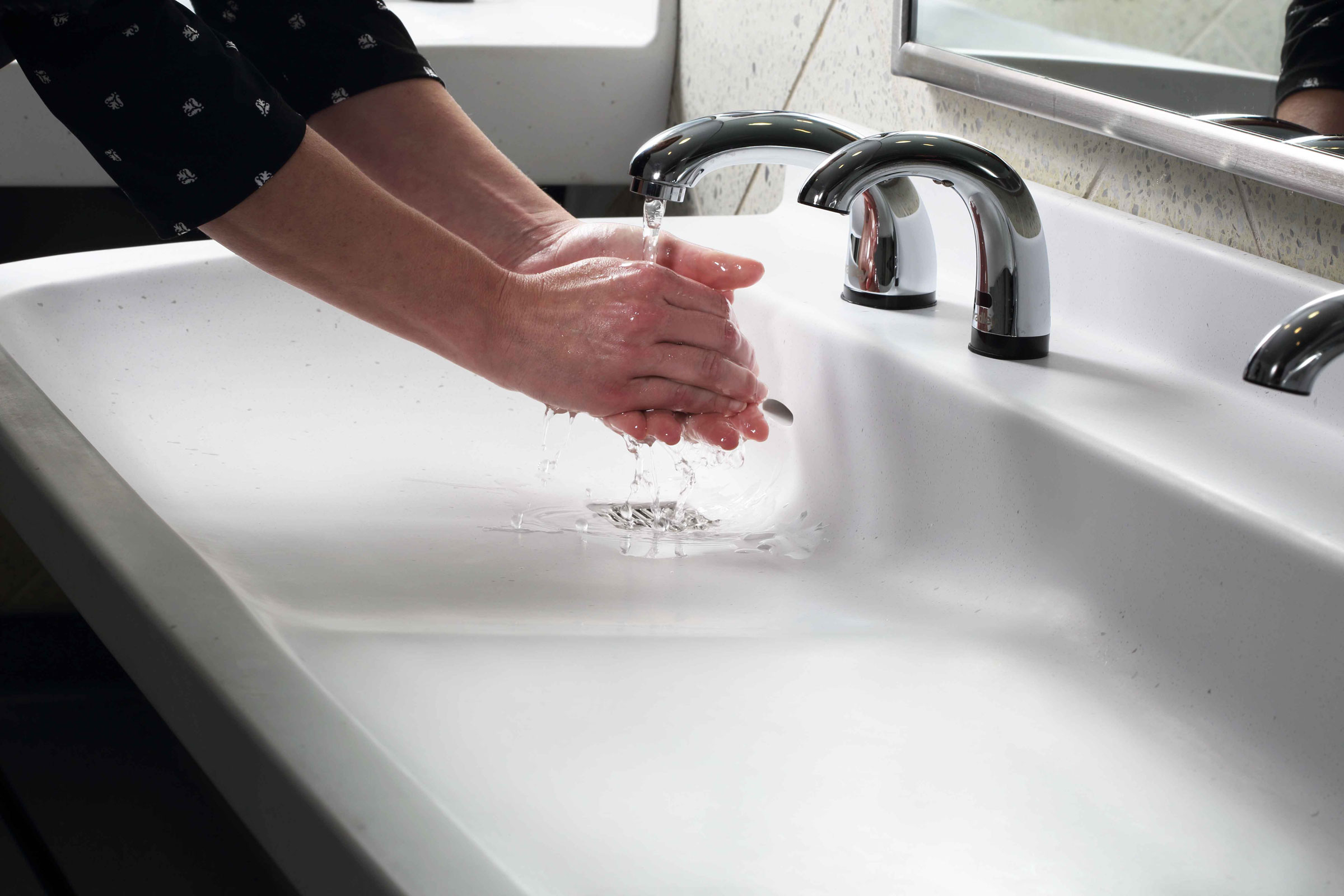
Bradley’s Express Lavatory Systems include hands-free soap and sanitizer dispensers, along with touchless sinks. Courtesy of Bradley Corp.
In spaces with high-touch surfaces, motion detection may be the answer. Touchless technology promotes a clean environment by limiting the need to make contact with buttons, door handles, sink faucets, and more.
“In a touchless office, the door can be automated using sensors at the entrance or near-field communication between a door access point and a user’s phone,” Robert Hemmerdinger, chief sales and marketing officer for Delta Controls, wrote in a previous article for gb&d. “People won’t need to touch the door handle to gain access to the space. Once they’ve entered, lighting can be adjusted automatically, and temperature preferences can be input with the user’s phone.”
When it comes to bathroom design, hands-free faucets, soap dispensers, and hand dryers eliminate the mess of paper towels and reduce the number of touchpoints in a restroom. Excel Dryer’s XLERATOR hand dryer also has the added bonus of boasting a 75% reduced carbon footprint compared to paper towels and traditional hand dryers.
10. Incorporate Antibacterial & Antimicrobial Products

Vistaprint’s LEED Platinum office includes antibacterial surfaces such as glass table tops and high-performance textiles. Photo courtesy of Margulies Perruzzi
Dianne Dunnell, former director of interior design at Margulies Perruzzi, recommends selecting inherently anti-bacterial products like quartz, silver, or copper, for building materials. “Both soapstone and quartz surfaces are highly resistant to bacteria and stains because they are nonporous,” writes Dunnell.
Metal ion products like pure silver and copper have been shown to be effective against bacteria and certain viruses. “Testing has found copper begins to eliminate germs upon contact and eliminating up to 99.9% of harmful bacteria within two hours,” Dunnell told gb&d.
Various textiles, paints, and laminates also offer antibacterial finishes—but be mindful, the antimicrobial qualities of these materials are intended to preserve the products’ surface from damage caused by microorganisms rather than prevent the spread of infection.
11. Mitigate Noise With Proper Acoustic Design
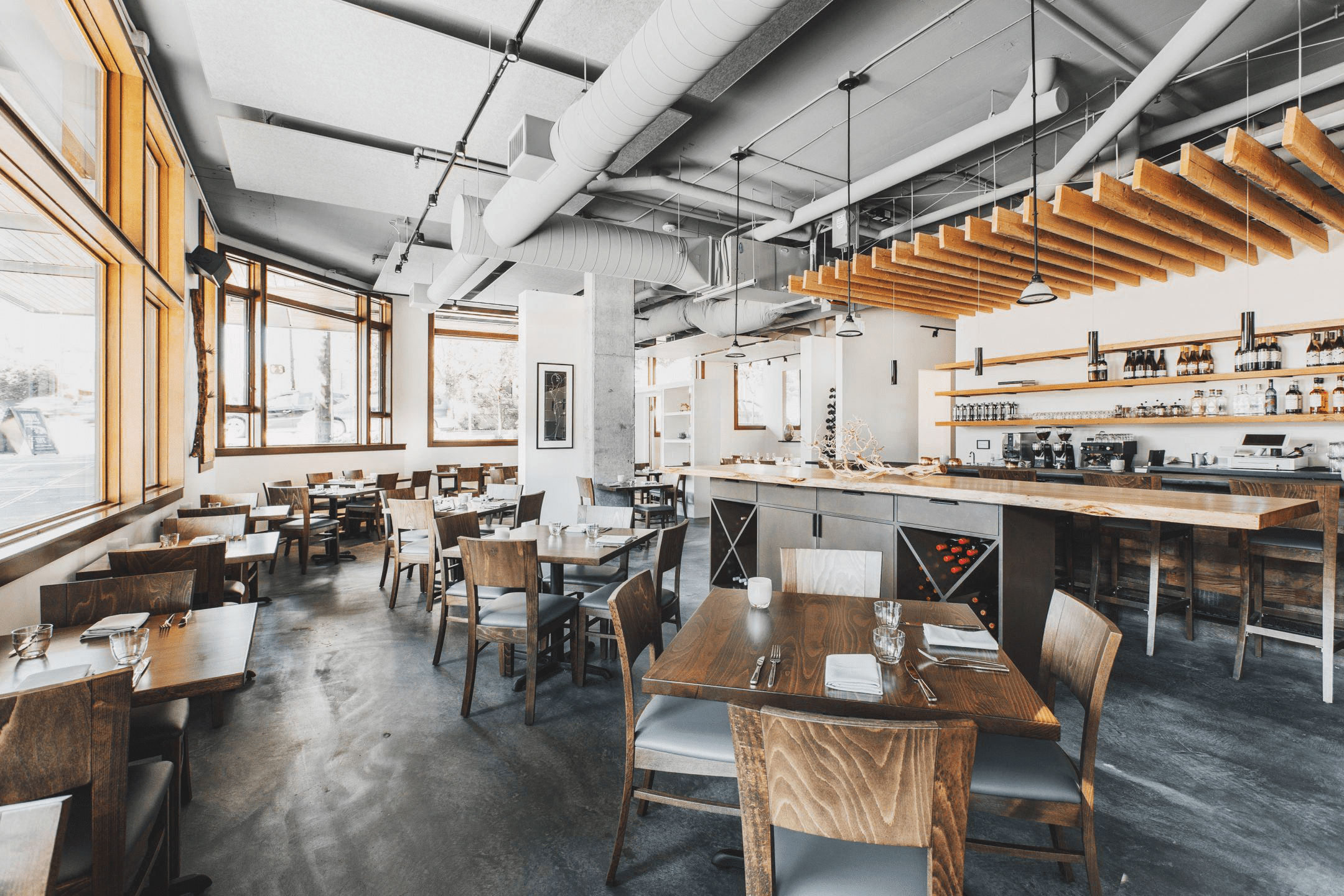
A collaborative workspace of tables and chairs beneath a thoughtful placement of FSorb Silentline Ocean baffles. In the kitchen, there is a lack of acoustical materials because it is intended to be livelier. Photo courtesy of FSorb
Excess noise can have harmful effects on your sleep, stress levels, and general health. A noisy home can impact sleep quality, which can lead to health issues like obesity, diabetes, and heart disease. Greenfiber’s SANCTUARY Blow-In or Spray-Applied Insulation can reduce noise pollution that comes from both inside and outside the house.
Beyond sleeping problems, excess noise exposure can also have a harmful effect on both children and adults. Noise exposure has been linked to poorer reading comprehension and standardized test scores in children, according to a 2018 World Health Organization analysis. A study published in The American Journal of Industrial Medicine in 2018 concluded that as many as 14% of cases of hypertension and 9% of cases of high cholesterol were potentially a result of noise exposure.
Situational acoustic design uses various tactics and materials to address where the loudest noise occurs in a space, Doug Bixel, CEO of FSorb, previously told gb&d. Acoustic design may make use of separating panels, thoughtful seating configurations, and even fabric walls.
A great tool in situational acoustic design is to place panels in between and/or above specifically noisy areas. These can create a break in sound from one area to the next. At its essence, the panel absorbs sound from the noise source. This is a great solution to the headache inducing noise caused by other collaborative activities.
12. UV-C Air Purification
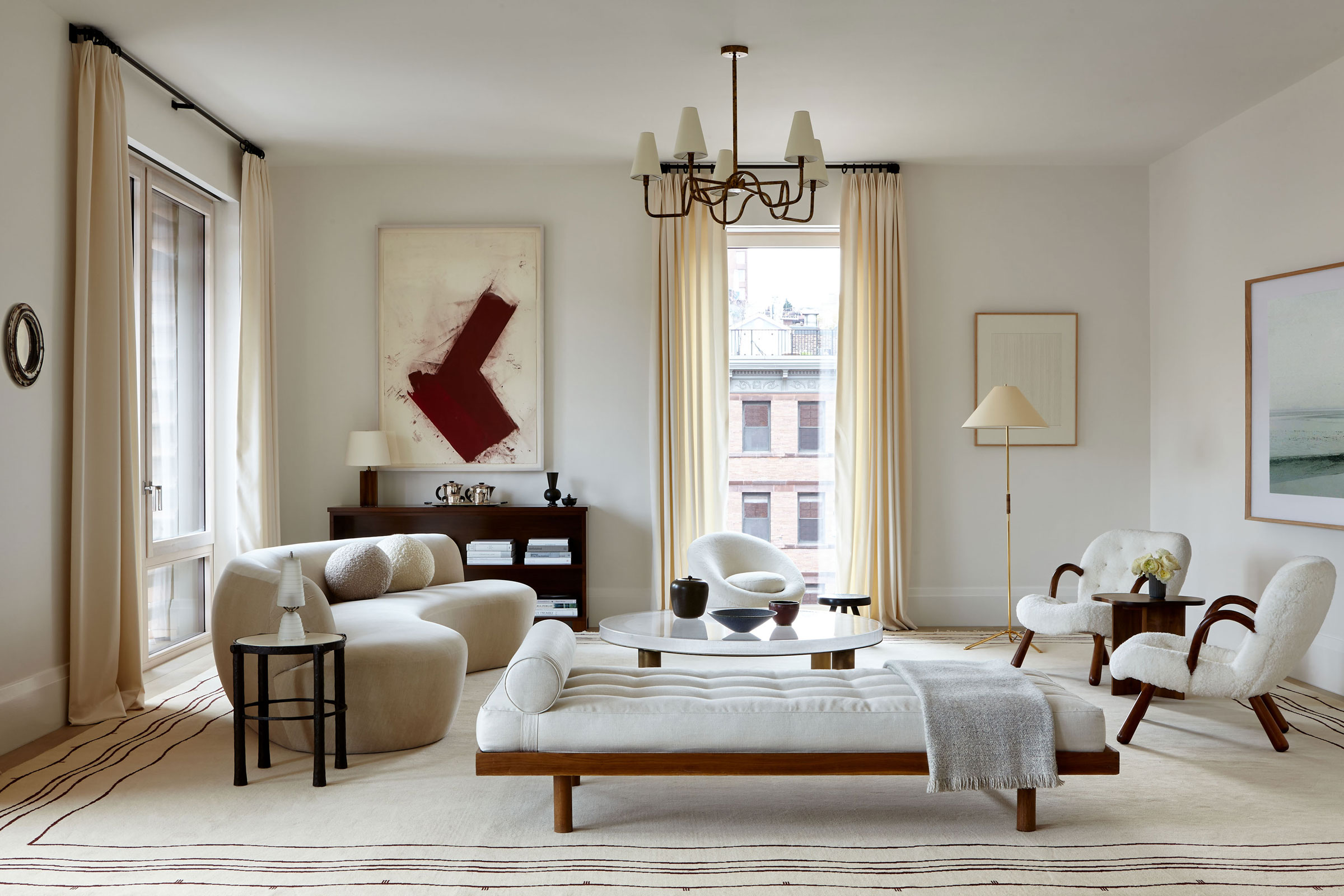
Charlotte of the Upper West Side was one of the first residential condominium buildings in New York to use UV-C light to irradiate germs and viruses. Photo by Joshua McHugh
Installing an HVAC UV-C lamp is another way to prevent airborne viruses, fungi, bacteria, and other illness-causing microorganisms from circulating throughout an indoor space. Ultraviolet, or UV, light has gained popularity as a disinfectant, especially in the wake of the SARS-CoV-2 global pandemic.
“The advantages of disinfecting lighting are it is environmentally friendly, rapidly kills anti-microbials within seconds, and does not create any resistance,” Dunnell previously wrote for gb&dPRO.
Germicidal UV light is categorized by various intensities, with UV-C light being the strongest, emitting radiation at a level between 185 and 254 nm. UV-C lamps break down the DNA/RNA of germs, destroy the nucleic acid in bacteria, and functionally prevent cell replication in other microbes, rendering them harmless. Because direct exposure to UV-C light is harmful to humans, UV-C lamps are best installed in HVAC systems where they can sterilize the air before it is circulated throughout a building.
Charlotte of the Upper West Side—a residential condominium in New York designed by BKSK Architects—utilizes UV-C light in its ventilation system to help irradiate germs and viruses for increased indoor air quality. “Within every ERV, as well as any supply air component of the HVAC or kitchen makeup air systems, high energy germicidal UVC light systems have been installed, emitting energy at 253.7 nanometer wavelength for optimal germicidal anti-virus irradiation,” Todd Poisson, partner at BKSK, previously wrote for gb&d.
13. Humidity Controls
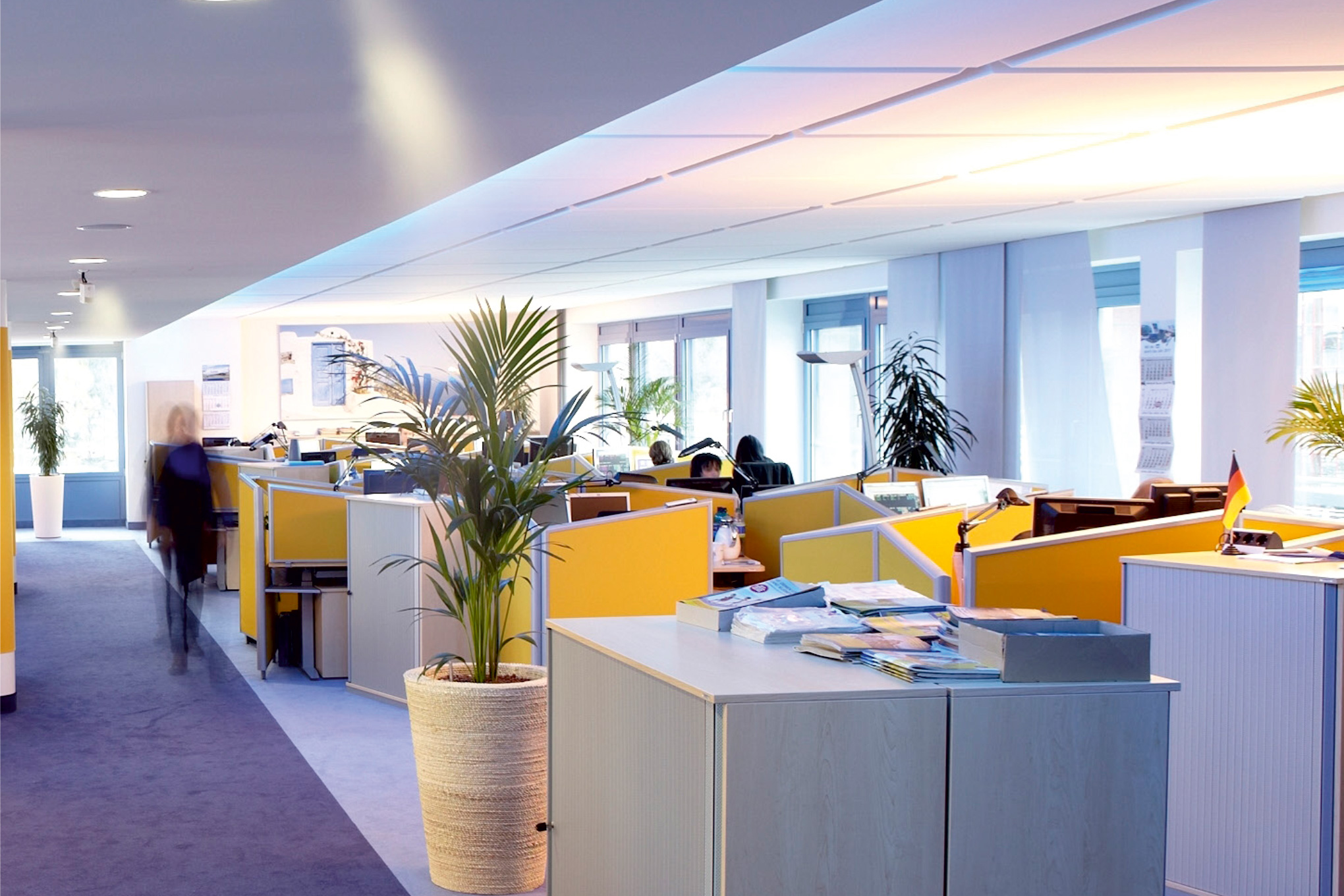
Optimizing indoor humidity levels helps to improve occupant health by reducing VOC off-gassing, moisture buildup, and too-dry air that can lead to dry skin and nosebleeds. Photo courtesy of Condair
High humidity levels in an interior space can negatively impact air quality as a result of excess moisture in the air. Eliminating humidity altogether isn’t ideal, as some ambient moisture is needed to prevent nosebleeds, coughing, and dry skin, but too much moisture can exacerbate asthma, allergies, and other respiratory conditions as well as lead to mold and mildew growth. When partnered with high temperatures, excessive humidity can also increase VOC off-gassing, which is why relative humidity levels should be kept between 30 and 50%, according to the EPA.
“The idea that mid-range indoor humidity is a powerful protector of our health is a revolutionary concept for building engineers,” Dr. Stephanie Taylor, an active member of ASHRAE and medical advisor to Condair Group, previously told gb&d. “It’s incredibly exciting that maintaining relative humidity indoors is now being recognized as ‘building medicine.’ Covid-19 has raised awareness of the importance of indoor environments and viral diseases in general.”
Geographic location and climate are the primary factors influencing ambient humidity, meaning each building will require a unique solution to achieve the desired indoor humidity level. Companies like Condair Group—the world’s leading manufacturer and specialist for industrial and commercial humidification, dehumidification, and evaporative cooling—can help building owners and managers figure out the best solution for their specific needs.
14. Install Radiant Heating
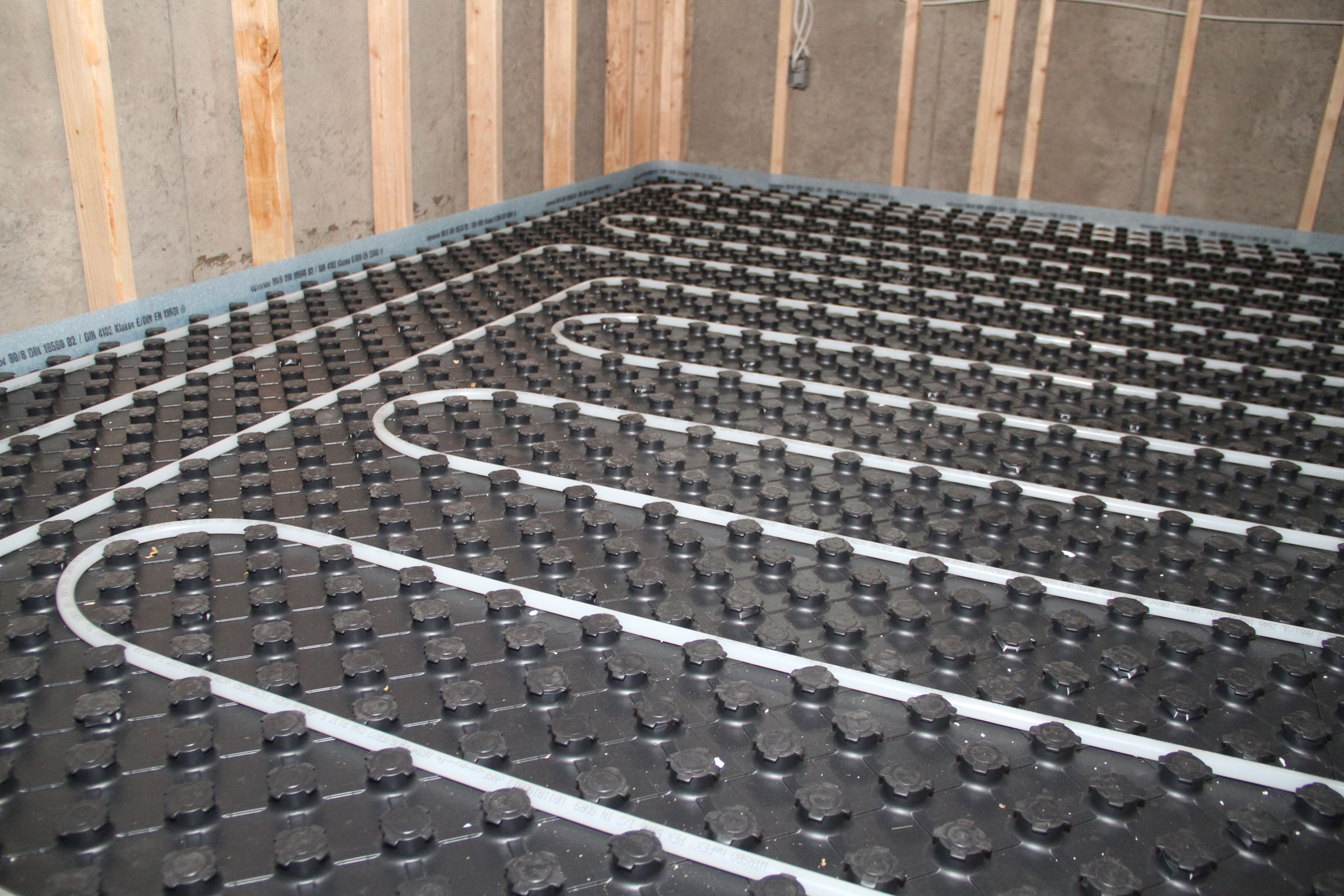
Hydronic radiant floor systems not only promote cleaner indoor air, but also boast a higher energy efficiency than standard air heating systems. Photo courtesy of Uponor
Radiant heating uses electricity, hot water, or air to supply heat directly to a building’s walls, floors, or ceiling panels. The heating coils or pipes make contact with the surface material and infrared radiation delivers the heat directly to a room’s occupants, objects, and air.
This use of contact to transfer heat means radiant heating systems do not disrupt allergens the way conventional forced air systems can. Plus, the lack of forced air system means radiant heating and cooling requires a dedicated outside air system. This means they cut out all recirculated air that would come from forced air systems and lead to better indoor air quality and healthier spaces.
Radiant heating systems are also typically installed as individual zones, each of which is designed to heat a specific area in a building and is controlled by its own thermostat. “Not only does this provide custom comfort control when people are in a space, it also makes the system even more energy-efficient because people can keep the heat low in spaces that are not in use,” Kim Bliss, content development manager at Uponor, previously wrote for gb&d.
Samantha Stevens contributed to this article.

